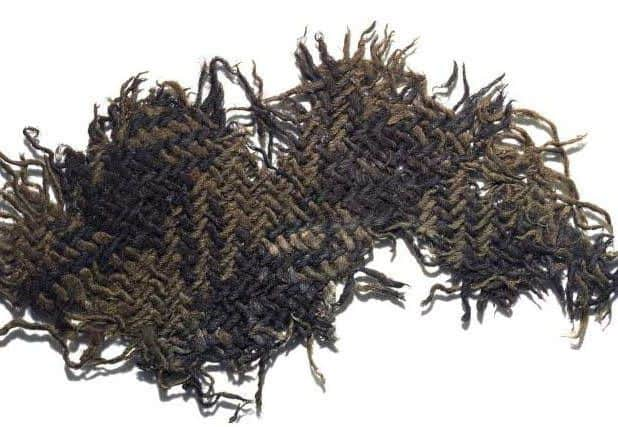Who wore Scotland's oldest piece of tartan?
This article contains affiliate links. We may earn a small commission on items purchased through this article, but that does not affect our editorial judgement.


It could have belonged to a tribal leader bribed with silver to stop Caledonians attacking the imperial invaders as they retreated south.
The fragment, believed to be the oldest piece of tartan found on British soil and held in the National Museums of Scotland, is estimated to be around 1,700 years old and was found close to the Antonine Wall at Bell’s Meadow, near Falkirk, in 1933.
Advertisement
Hide AdAdvertisement
Hide AdThe tartan was used as a stopper on a pot which contained some 1,900 Roman coins with the fragment of cloth believed to belong to a local high-status person.


Dr Fraser Hunter, principal curator of Iron Age, Roman, Early History at the National Museums of Scotland, said the fabric was relatively fine and likely came from a tunic or trousers.
He said; “The latest coins in the hoards come from around 230 AD, long after the Romans left the Antonine Wall.
“We think the silver is a bribe to some local leader and tells us something about who owned the hoard.”


The Romans fully retreated from the Antonine Wall for Hadrian’s Wall around 165 AD although the last solider did not leave Great Britain until 410AD.
Geoff Bailey, keeper of archaeology & local history at Falkirk Community Trust said: “Even after Romans left the area, there was still a Roman influence here.
“These coins are usually considered a bribe to stop the local people going down to Hadrian’s Wall to beat up the Romans. It’s a way of keeping the peace - and cheaper than having a standing army in Scotland.”
Advertisement
Hide AdAdvertisement
Hide AdFalkirk was a major centre of population at the time, Mr Bailey said, with nearby Wormit Hill usually assumed to be the stronghold of the local tribal chief.
Evidence had suggested an “elite presence” in the area at the time with Falkirk and nearby Camelon both large villages.
Recently, a metal detectorist found a ring from a chariot in the area, Mr Bailey added.
Following the discovery of the coins, Sir George Macdonald, an eminent archaeologist and coin expert who studied the Falkirk Hoard said the jar contained “the outcome of perhaps 120 years of thrift, the family savings of four generations.”
He recorded at the time: “We do not know, nor can we ever know, how the money was made. But we have the best of reasons for believing that it was made far to the north of Hadrian’s Wall and that the owners were not Roman intruders. They were dwellers in Caledonia.”
In a later paper to the Society of Antiquaries Scotland, the late historian Malcolm Todd said the hoard was collected over around 70 years.
Todd also argued that the Bell’s Meadow find was an “imperial subsidy” to secure support beyond the frontier of the Antonine Wall.
Advertisement
Hide AdAdvertisement
Hide AdSimilar tactics had been used by the Romans at the Rhine and Danube, Todd said.
He added: “We may legitimately suspect that in other cases peace was bought over a protracted period by means of repeated monetary and other payments.”
“How might the Falkirk silver hoard fit into this context? It would seem, with considerable ease. Its composition is entirely consonant with payments made to a barbarian leader or dynasty over a period that extended from the Antonines to the rulers of the earlier third century.”
Tartan-style checked material was “relatively common” throughout Northern Europe at this time, Dr Hunter of National Museums of Scotland said.
What was rare is that this fragment had survived, he added, with the coins found in the hoard key to its longevity.
Dr Hunter said: “Textile normally doesn’t survive given that it is usually destroyed by bacteria but this fragment was preserved in a very special way.
“It was used to close the mouth of a pot - and in that pot was around 1,900 silver Roman coins
Advertisement
Hide AdAdvertisement
Hide Ad“Roman silver wasn’t exactly silver - it was often diluted with copper and as copper corrodes it creates this toxic environment.
“It was this toxic environment that had kept the bacteria at bay and allowed the preservation of the cloth.”
DOWNLOAD THE SCOTSMAN APP ON ITUNES OR GOOGLE PLAY
